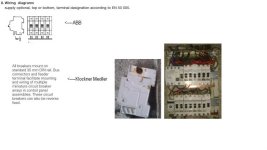Liam, I'm very sorry for your loss. That cannot have been easy.
Ar dheis Dé go raibh a anam.
It does not make what I am about to type any easier.
From what I am reading, a lot has been mentioned about the dangers of bottom supplied circuit breakers. While not common practice, it is not unheard of or to be assumed non-existent.
The Plc Kid, I know it was a rant, but in post #6, your first and last paragraphs are highly contradictory? It cannot be both a legal method of wiring and also a life safety issue? The latter would not allow the former. What is normal practice one side of the globe may be outlawed on the other. But your mis-understanding the real and common danger here.
This is something I have always tried to teach apprentices I have worked with.
The danger is from what is flowing through the circuit breaker, not how. Unfortunately, assumptions and a certain amount of complacency is what injures or kills in these cases. Lessons, such as Liam's brother, should be learned from, but for a different reason than most of you are thinking.
With the exception of Lancie1's case, as I've never worked on HV systems, so I don't know the regs, or what PPE and test equipment should have been used. This should have been clearly marked is the least I will say on it.
You should never assume a circuit is dead just because a breaker is off. The dangerous practice is not testing the circuit with a meter, not someone else wiring it incorrectly, oppositely, against the drawings, even regs. It's your life, it's your responsibility.
Walking up to a distribution board, or panel, and turning off the required breaker is not enough to proceed to begin disconnection. Even if you have checked it at the circuit breaker, or fuse, on what you think is the load side, and it is dead, always check it at the point of disconnection as well. This Liam, is good sense, but alas, not common sense. It's a simple rule which may save a life.
I've had to learn this lesson the hard way. I received too many jolts in my earlier years through assumptions and complacency.
I once isolated and tested a 3 phase breaker load side and then proceeded to disconnect the 3 phases at an external j-box. I got the first one out no problems, but when I disconnected the second, I ended up with 380vac across my chest. I managed to pull free, but left a lump of one of my fingers behind. I wasn't right for 2 days. I had shakes in my right arm for a long time. I had turned off what was an incorrectly labeled breaker for something else. I didn't check the voltage at the point of disconnection. In this case the breaker was top fed, but it demonstrates how the assumptions we make go beyond even the direction of the supply.
There may or may not be regulations that state what way you feed anything, but it's the supply that may kill you, not what way it's flowing.
Yes, people should be safety conscious, and follow good practices and regs, and drawings for whatever region of the world they work in. But inevitably you will most likely come across someones "different" wiring at some stage in your career.
As Liam mentioned, DBs and even domestic consumer units are bottom fed here. If you do domestic, commercial and industrial electrical work you will meet all sorts of circuits, and I have. But my meter always goes on the point of disconnection.
I worked on a old panel today with top fed MCBs. I replaced a burnt out contactor coil. Yesterday I had to replace a burnt out bottom fed socket circuit MCB on my wife's parents board. A loose connection had caused a ring main to burn off at the load side of the MCB. But the same rule applies, they are both live circuits until I ensure they are not at the point of disconnection.
Circuit breaker, fuse, or electronic fuse manufacturer's wiring specifications are what you should follow with regard to how you supply them. But beware, many allow supply from both sides.
To answer the opening question, they are perfectly entitled to specify this wiring configuration. Once the selected equipment and local regs allow it. It does not need to be labeled anymore or less than any other circuit. Its drawings need not be anymore specific to the fact than any other, once they are accurate. You read drawings and labels as guides to what has been done, but only guides. You determine for yourself when it is safe to work on, not anyone or anything else.
I've attached 2 examples of well known breaker manufacturers wiring option notes. I also added the consumer unit and offending MCB from yesterday for good measure.
The only assumption you should make is that it is not dead until you make sure it is. If it always was, then it always will be, should not be your mantra.
G.






